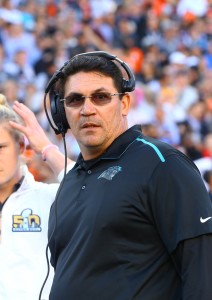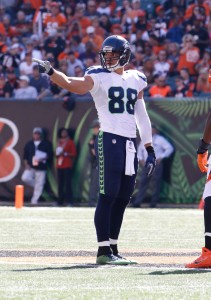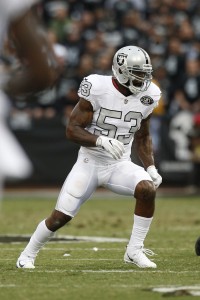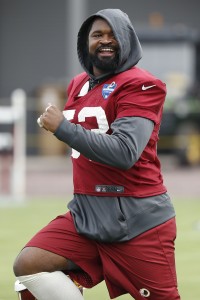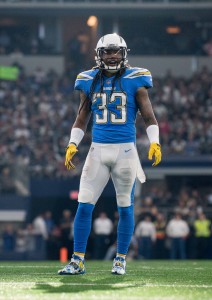2024 Hall Of Fame Class Unveiled
As part of tonight’s NFL Honors program, the 2024 Pro Football Hall of Fame class has been revealed. It consists of modern-era standouts and two players chosen by the senior committee. Here is the full breakdown of this year’s honorees:
Dwight Freeney, defensive end (2002-17)
In his second year as a finalist, Freeney received enough support to be voted into the Hall. One of the quickest edge rushers in NFL history, Freeney will reach Canton with 125.5 career sacks. That total ranks 18th in NFL history. The Colts made Freeney their pass-rushing anchor during Peyton Manning‘s extended run as their franchise centerpiece. While the team eventually found a bookend in Robert Mathis, it chose Freeney 11th overall in the 2002 draft with a hope of building a pass defense around the Syracuse alum. Freeney delivered and will book a Hall of Fame nod on his second try.
 Freeney finished second to fellow 2024 inductee Julius Peppers in 2002 Defensive Rookie of the Year voting, but the spin-move maven showed what was ahead by forcing nine forced fumbles as a rookie. The 11-year Colt earned four All-Pro honors, joining Mathis as one of the era’s defining pass-rushing duos. Freeney led the NFL with 16 sacks in 2004 and helped the Colts vanquish their Patriots hurdle en route to a Super Bowl XLI win two years later. The Colts gave Freeney a six-year, $72MM extension in 2007.
Freeney finished second to fellow 2024 inductee Julius Peppers in 2002 Defensive Rookie of the Year voting, but the spin-move maven showed what was ahead by forcing nine forced fumbles as a rookie. The 11-year Colt earned four All-Pro honors, joining Mathis as one of the era’s defining pass-rushing duos. Freeney led the NFL with 16 sacks in 2004 and helped the Colts vanquish their Patriots hurdle en route to a Super Bowl XLI win two years later. The Colts gave Freeney a six-year, $72MM extension in 2007.
The enduring sack artist managed to play five seasons following his Colts career, spending time with the Chargers, Falcons, Cardinals, Seahawks and Lions. Serving as a designated rusher near the end of his career, Freeney helped the Cardinals reach the 2015 NFC championship game, after an eight-sack season, and played in Super Bowl LI with the Falcons.
Randy Gradishar, linebacker (1974-83)**
Widely viewed as one of the best linebackers of his era and one of the game’s best tacklers of any period, Gradishar moves into the Hall via the senior committee route. Gradishar’s selection makes him the first member of the Broncos’ “Orange Crush” defense to be enshrined in Canton. That defensive nucleus powered Denver to its first playoff berth, a 1977 season that included postseason wins over 1970s superpowers Pittsburgh and Oakland en route to Super Bowl XII. The Broncos allowed just 10.6 points per game in 1977. Despite multiple rule changes designed to increase offensive productivity in 1978, the Broncos yielded just 12.4 points per contest that year.
A first-round pick out of Ohio State, Gradishar played his entire career in Denver and earned five All-Pro honors. The above-referenced 1978 season featured perhaps the best team in Steelers history, but Gradishar outflanked “Steel Curtain” cogs by being voted as Defensive Player of the Year after helping the 10-6 Broncos back to the playoffs. The off-ball linebacker added 20 interceptions and four defensive touchdowns in his career.
Devin Hester, return specialist (2006-16)
Almost definitely the greatest return man in NFL history, Hester becomes one of the few true specialists in the Hall of Fame. Dabbling at cornerback and wide receiver, Hester provided the Bears tremendous value as a return specialist. Elite in both the kick- and punt-return capacities, Hester set an NFL record with 20 return touchdowns. Famously adding a kick-return score in the playoffs — to begin Super Bowl XLI — Hester delivered one of the great rookie seasons in NFL history. The Bears second-round pick notched six return TDs in the regular season — one coming on a blocked field goal sprint against the Giants — and added No. 7 against the Colts in the Super Bowl.
 Hester’s 2007 season dismissed any fluke notions; he posted six more return scores (four on punts) during his NFL sophomore slate. While producing 17 more TDs on offense over the course of his career, Hester never caught on as a pure wideout in Chicago. But he landed on two All-Decade teams for his return work. Eighteen of Hester’s 19 return TDs came in Chicago. Hester’s 14 punt-return TDs are four more than second place all time (Eric Metcalf); he broke the record for combined kick- and punt-return TDs in only his sixth season (2011).
Hester’s 2007 season dismissed any fluke notions; he posted six more return scores (four on punts) during his NFL sophomore slate. While producing 17 more TDs on offense over the course of his career, Hester never caught on as a pure wideout in Chicago. But he landed on two All-Decade teams for his return work. Eighteen of Hester’s 19 return TDs came in Chicago. Hester’s 14 punt-return TDs are four more than second place all time (Eric Metcalf); he broke the record for combined kick- and punt-return TDs in only his sixth season (2011).
The Falcons gave Hester a three-year, $9MM contract in 2014; he finished his career splitting time with the Ravens and Seahawks in 2016. Seattle signed Hester just before the 2016 playoffs, using him in both its postseason contests that year.
Andre Johnson, wide receiver (2003-16)
Not collecting a Super Bowl ring like the other two pure wide receiver finalists in this year’s class (Torry Holt, Reggie Wayne), Johnson became well known for putting up monster numbers despite not being gifted a top-tier quarterback. But Johnson operated as one of the most physically imposing receivers in NFL history. The ex-Miami Hurricanes star’s numbers, largely compiled with David Carr and Matt Schaub targeting him, reflect that. Of Johnson’s seven 1,000-yard receiving seasons, four included 1,400-plus. Only Jerry Rice (six) and Julio Jones (five) produced more such seasons. Johnson’s 14,185 career yards rank 11th all time.
The Texans chose Johnson third overall in 2003, the second draft in their history. The 229-pound pass catcher led the NFL in receptions twice and receiving yards in back-to-back years (2008, 2009). Neither of those seasons lifted the Texans to a playoff berth, but Johnson remained in place as the team’s No. 1 wideout when the team finally booked its first two postseason cameos in 2011 and 2012. Johnson amassed 201 yards in two playoff games in 2011, doing so despite Schaub’s injury leaving rookie T.J. Yates at the controls.
 Johnson is the Texans’ first Hall of Famer. This is fitting, as he retired with the most games played in Texans history. The longtime WR1 spent 12 years with the team. Johnson signed two Houston extensions spanning at least seven years in length, earning more than $108MM throughout his NFL run. He finished a 14-year career with one season apiece in Indianapolis and Tennessee.
Johnson is the Texans’ first Hall of Famer. This is fitting, as he retired with the most games played in Texans history. The longtime WR1 spent 12 years with the team. Johnson signed two Houston extensions spanning at least seven years in length, earning more than $108MM throughout his NFL run. He finished a 14-year career with one season apiece in Indianapolis and Tennessee.
Steve McMichael, defensive tackle (1980-94)**
Part of the storied 1985 Bears’ defense, McMichael played 13 of his 15 NFL seasons in Chicago. A Patriots third-round draftee, McMichael found himself in the Windy City ahead of his second season. The Patriots waived the future D-line mainstay during the 1981 offseason. Teaming with fellow Hall of Famers Dan Hampton and Richard Dent (along with William “The Refrigerator” Perry) on Chicago’s D-line, McMichael earned four All-Pro honors while helping a Bears team — one that saw Jim McMahon injuries impede paths to Super Bowls — become a perennial contender.
The Bears did, of course, break through as champions in 1985. That 18-1 team is on a short list of those in the running for the best ever, allowing only 12.4 points per game and outscoring its playoff opposition 91-10. McMichael started 16 games for the ’85 team and suited up every week for an ’86 Bears defense that statistically outflanked its famed predecessor. Better known by some as part of WCW’s Four Horsemen faction during his wrestling career, “Mongo” finished his gridiron run with 95 sacks (three of them safeties). McMichael closed out his NFL stay with the Packers in 1994. His 92.5 sacks with the Bears are second in franchise history.
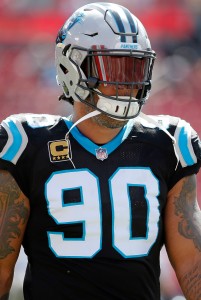 Julius Peppers, defensive end (2002-18)*
Julius Peppers, defensive end (2002-18)*
Five years after retiring, Peppers remains fourth on the NFL’s all-time sack list (159.5). The former Panthers, Bears and Packers pass rusher finished a half-sack shy of Kevin Greene for third. While Greene needed to wait a bit before enshrinement, voters will send Peppers to Canton on his first try. The former North Carolina two-sport standout came into the league with high expectations, going off the 2002 draft board second overall. He justified those, remaining a productive pass rusher into his late 30s. No active sack artist is within 35 of Peppers’ career total. He is among the rare players to land on two All-Decade teams.
Peppers collected six All-Pro honors, three as a first-teamer, and did quite well on the contract front. Peppers’ rookie contract spanned seven years (and $46MM, before the 2011 CBA introduced the slot system), and the Panthers kept him off the market with a franchise tag ahead of Year 8. During the uncapped 2010, Peppers landed a then-record-setting DE pact from the Bears (six years, $84MM). He played four seasons on that deal, and after the Bears made the 6-foot-6 rusher a cap casualty in 2014, Peppers made an impact for three playoff-bound Packers teams in the mid-2010s.
While this can be considered a big night for the Bears — due to the enshrinements of three former players — Peppers played 10 years with the Panthers, returning home to close out his 17-season run. Fifteen years after he won Defensive Rookie of the Year honors in Charlotte, the North Carolina native re-signed with his hometown team. Peppers’ penultimate season brought a 10th double-digit sack showing; he totaled 11 at age 37 to help the Panthers to their most recent playoff berth.
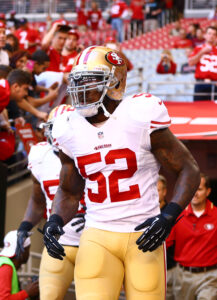 Patrick Willis, linebacker (2007-14)
Patrick Willis, linebacker (2007-14)
Willis did not overstay his welcome in the NFL, retiring after his age-29 season. The dominant inside linebacker did not lack for accolades in his eight-year career, racking up six All-Pro honors — including five first-team distinctions. The 49ers nabbed Willis in the 2007 first round and turned him loose. Although San Francisco did not form the Jim Harbaugh–Vic Fangio pairing until Willis’ fifth season, he flashed frequently as a young player and was regarded by many as the NFL’s best off-ball linebacker for an extended period.
The Ole Miss alum picked up Defensive Rookie of the Year acclaim and became the rare player to win that award while earning first-team All-Pro honors. Willis tallied a career-high 174 tackles — including a staggering 136 solo — as a rookie to provide an indication of his capabilities. Willis remained in his prime when Harbaugh and Fangio arrived in 2011. While Harbaugh’s arrival elevated Alex Smith and then Colin Kaepernick, Willis’ presence represented a key part of a defense-geared 49ers blueprint that produced three straight NFC championship games and a berth in Super Bowl XLVII.
Willis teamed with NaVorro Bowman to form one of the great linebacking pairs in modern NFL history. Seeing each soar to the first-team All-Pro perch, the 49ers went second-second-third in scoring defense from 2011-13. After suffering a foot injury midway through the 2014 season, Willis opted to call it quits.
* = denotes first year of eligibility
** = denotes senior candidate
This Date In Transactions History: Julius Peppers
After a mysteriously quiet 2007, Julius Peppers mounted a strong comeback campaign in ’08. Then, on the heels of notching a career-high 14.5 sacks and helping the Panthers return to the playoffs, Peppers wanted out. Specifically, Peppers expressed a desire to join a team with a 3-4 scheme so that he could move from defensive end to linebacker. 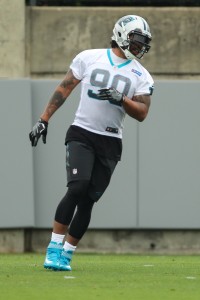
Peppers insisted that he would never sign a long-term deal with Carolina and tried hard to discourage the team from using the franchise tender on him in the 2009 offseason.
“The front office has been informed of my desire to explore opportunities with other NFL teams following the expiration of my contract next month,” Peppers said in a statement (via ESPN.com). “At this point in my NFL career, I am seeking new challenges that will allow me to grow, develop and reach my personal potential on the football field.”
The Panthers held firm, however, and applied the one-year, $16.7MM placeholder on their top defender. In theory, another team could have signed Peppers as a restricted free agent, but that would have required the forfeiture of two first-round picks on top of a mammoth contract. While he was stuck between a rock and a hard place, Peppers abstained from offseason activities. The multiple-time Pro Bowler’s absence cast a serious shadow over the Panthers’ offseason and made the football world wonder whether the Panthers would cave and trade him.
Ultimately, Peppers’ agent was unable to find a suitable deal for him. And, on June 26, 2009, Peppers inked his one-year deal with the Panthers.
Peppers earned another Pro Bowl nod in 2009, and that proved to be the final season of his first Panthers run. After the season, the Panthers declined to use the franchise tag on him, allowing him to reach unrestricted free agency and to a six-year, $91.5MM deal with the Bears. When that deal was terminated in 2014, he stayed in the NFC North and signed with the Packers.
It took a while, but Peppers ultimately came full circle. In 2017, the veteran joined the Panthers on a one-year, $3.5MM deal. A few months later, the Panthers canned GM Dave Gettleman and brought back Marty Hurney as their top football executive, but there were no hard feelings between Peppers and Hurney.
Last March, Peppers and Hurney shook hands on a new one-year, $5MM deal to keep the then 38-year-old in Carolina. Then, this past February, Peppers walked away from the game with 159.5 career sacks.
Extra Points: Collins, Peppers, Raiders
Dealing with several young talents’ contract situations, the Cowboys certainly may have to let a couple of their contract-year starters walk. One of those the team may be ready to stomach departing: La’el Collins. Dallas’ starting right tackle is already on his second NFL contract, and it expires after the season. The Cowboys are expected to let Collins depart after 2019, Calvin Watkins of The Athletic notes (subscription required). Joining Dak Prescott, Amari Cooper, Jaylon Smith and Byron Jones as key Cowboys in walk years, Collins would stand to be a key presence on the 2020 free agent market. While Cowboys executive VP Stephen Jones mentioned him as a player the team would like to retain, Watkins adds the team does not want to shell out a big contract to keep him — which obviously means not going near the prices Trent Brown and Ja’Wuan James received in March. This would make sense, with the Cowboys already having three well-paid offensive linemen — Tyron Smith, Zack Martin and Travis Frederick — on their roster.
The Cowboys drafted Connor McGovern in the third round and have 2018 second-rounder Connor Williams set to compete with him and Xavier Su’a-Filo for the left guard position this season. Williams may be in the mix to take over at right tackle next season, should McGovern or Su’a-Filo win this year’s left guard job, per Watkins.
Here is the latest from around the NFL:
- Julius Peppers wrapped up one of the most successful careers in edge rusher history but will not be leaving the Panthers. The recently retired defensive end will take a job with the Panthers, his title being “special assistant, business operations,” the team announced. It does not sound like the 39-year-old future Hall of Famer will be contributing to the front office’s efforts, but perhaps that type of role could be in his future.
- Speaking of former players landing on staffs, former Redskins safety Kyshoen Jarrett will break into full-time coaching. Jarrett is now a Redskins defensive quality control coach, per NBC Sports Washington. Suffering a career-ending injury as a rookie, Jarrett worked as a Washington coaching intern last season.
- In addition to hiring former Cowboys scout Jim Abrams as their new college scouting director, the Raiders added Dwayne Joseph as their pro scouting director, Scott Bair of NBC Sports Bay Area notes. Joseph spent the past four years in the same role with the Eagles and was a Bears staffer prior to that. With Mike Mayock retooling Oakland’s scouting department, more hires are on the way.
- The Broncos will no longer have a Kubiak on their staff. After Gary and Klint Kubiak left for the Vikings, one of Gary’s other sons — Klein Kubiak — will not be part of the Broncos’ staff going forward. Klein Kubiak worked as the team’s southeast area scout, but his contract was not renewed, per Nicki Jhabvala of The Athletic (on Twitter). Frantzy Jourdain will fill the position. Jordan spent the past three years with Houston, serving as first an area scout and then a national scout, and the previous 13 in New England. The Texans parted ways with Jourdain last month.
Panthers’ Julius Peppers Retires From NFL
Panthers defensive end Julius Peppers announced his retirement from football on Friday morning. The 39-year-old is hanging ’em up after 17 seasons in the league. 
Peppers leaves the game after a storied career and the fourth-most sacks in NFL history. Many thought Peppers would have continued to play for at least another season to jump to third on the all-time list – his 159.5 sack total is just half a sack behind Kevin Greene.
“Anybody who knows me knows I’m not big on words and I don’t like to put myself out there, so I’m just gonna get right to it,” Peppers wrote in a piece for The Players’ Tribune. “Seventeen years is a long time to be playing this game. It’s two careers for a lot of people. I’m thankful that I have been able to play so long and still be healthy. I’m not all banged up and beaten down. I still feel good. But as much as I would love to play forever, I know that I can’t. It’s gotta end at some point. That point is now. Today, I’m retiring.”
The UNC product was a star from the get-go as he tallied 12 sacks in 12 games as a rookie. He spent his first eight years in the league with the Panthers, but when the two sides couldn’t agree to terms on a new deal in 2010, he joined up with the Bears on a six-year, $91.5MM deal. Later, he hooked on with the Packers before returning home to Carolina in 2017.
“In getting to know Julius over these past months, I’ve learned that he is a man of few words. When he speaks, everyone listens. With that in mind, I will be brief. He’s one of the best to ever wear a Carolina uniform,” new Panthers owner David Tepper said in a statement released by the team. “He carries himself with dignity, integrity and class, and will always be a Panther.”
Peppers was hoping for something better than back-to-back 7-9 seasons to wrap up his career, but he came full circle nonetheless and excelled on a personal level. He notched eleven sacks in ’17 and was still productive last season with five QB takedowns. According to Pro Football Focus, Peppers graded out as the No. 21 DE in the NFL last year (tied with Ryan Kerrigan and Michael Bennett).
We here at PFR wish Peppers the best in retirement.
Latest On Ron Rivera, Marty Hurney, Panthers’ Vets
Last week, we heard that Panthers head coach Ron Rivera would likely remain with the team in 2019, and Jason La Canfora of CBS Sports and Ian Rapoport of NFL.com confirm as much. Both reporters believe there could be changes made to Rivera’s coaching staff, however, and Rapoport expects such changes would be made primarily on the defensive side of the ball. Having Rivera take over defensive play-calling duties earlier this season has already paid dividends, but Rapoport suggests that the team could look to reunite with former DC Steve Wilks if Wilks is fired by the Cardinals (as is expected).
In any event, JLC says that Rivera and new owner David Tepper will have a candid conversation after the season, and if Rivera balks at Tepper’s demand for changes to the composition of Rivera’s staff, then the situation could deteriorate. But for the moment, it appears as if Rivera will be back for his ninth year at the helm, though he will have at least a few different subordinates. Rapoport says that GM Marty Hurney is likely safe as well. David Newton of ESPN.com spoke to Tepper today, but Tepper declined to comment on Rivera’s status.
Meanwhile, as Joe Person of The Athletic writes, the Panthers are expected to bid adieu to at least a couple franchise icons. Julius Peppers is expected to retire, and Thomas Davis has indicated he would like to be back with the club, but his contract is up at the end of the year and there is no guarantee he will be back. Of course, Ryan Kalil announced back in January that this season would be his last, and he has not given any indication that he has changed his mind. While Greg Olsen expects to return in 2019, and though the team is exploring a new deal with safety Eric Reid, there will be significant turnover to a roster that has been one of the league’s oldest over the past several seasons. Person offers his take on what the Panthers should do with their top ten players on expiring contracts.
It has become clear to most everyone, including Person and Newton, that Devin Funchess will not be back with the club in 2019. Funchess is inactive for today’s finale, and his playing time had already decreased significantly in the second half of the season.
Julius Peppers Comes Off PUP List
Panthers defensive end Julius Peppers has passed his physical and has been removed from the PUP list, as David Newton of ESPN.com reports. The team has a practice at 3:15 this afternoon, and Peppers will participate.
Peppers reunited with the Panthers last offseason after a four-year run with the Bears and a three-year stint with the Packers. The former No. 2 overall pick turned back the clock, as he posted 11 sacks for Carolina in 2017, his highest total since the 2012 campaign. His efforts made him the best pass rusher on this year’s free agent market in our eyes, despite the fact that he is now 38 years old.
Sack totals are not necessarily indicative of overall performance, but Pro Football Focus graded Peppers as a league-average defensive end last year, ranking him 63rd among 110 qualifying edge defenders. He played 50% of Carolina’s defensive snaps in 2017, and he’ll likely continue in a rotational role during the upcoming season.
The surefire Hall-of-Famer will earn $5MM in 2018, which represents a nice raise from the $3.5MM he made last year. He has accumulated a whopping 154.5 sacks in his career, the fourth-most in league history, and he could pass Kevin Greene‘s 160 mark this season. He also has nine Pro Bowls and three first-team All-Pro selections to his credit, but he is still chasing that elusive Super Bowl ring. He is hoping to achieve that last milestone with the team that drafted him over 16 years ago.
This Date In Transactions History: Julius Peppers
After a mysteriously quiet 2007, Julius Peppers mounted a strong comeback campaign in ’08. Then, on the heels of notching a career-high 14.5 sacks and helping the Panthers return to the playoffs, Peppers wanted out. Specifically, Peppers expressed a desire to join a team with a 3-4 scheme so that he could move from defensive end to linebacker. 
Peppers insisted that he would never sign a long-term deal with Carolina and tried hard to discourage the team from using the franchise tender on him in the 2009 offseason.
“The front office has been informed of my desire to explore opportunities with other NFL teams following the expiration of my contract next month,” Peppers said in a statement (via ESPN.com). “At this point in my NFL career, I am seeking new challenges that will allow me to grow, develop and reach my personal potential on the football field.”
The Panthers held firm, however, and applied the one-year, $16.7MM placeholder on their top defender. In theory, another team could have signed Peppers as a restricted free agent, but that would have required the forfeiture of two first-round picks on top of a mammoth contract. While he was stuck between a rock and a hard place, Peppers abstained from offseason activities. The multiple-time Pro Bowler’s absence cast a serious shadow over the Panthers’ offseason and made the football world wonder whether the Panthers would cave and trade him.
Ultimately, Peppers’ agent was unable to find a suitable deal for him. And, on June 26, 2009, Peppers inked his one-year deal with the Panthers.
Peppers earned another Pro Bowl nod in 2009, and that proved to be the final season of his first Panthers run. After the season, the Panthers declined to use the franchise tag on him, allowing him to reach unrestricted free agency and to a six-year, $91.5MM deal with the Bears. When that deal was terminated in 2014, he stayed in the NFC North and signed with the Packers.
It took a while, but Peppers ultimately came full circle. In 2017, the veteran joined the Panthers on a one-year, $3.5MM deal. A few months later, the Panthers canned GM Dave Gettleman and brought back Marty Hurney as their top football executive, but there were no hard feelings between Peppers and Hurney. This past March, Peppers and Hurney shook hands on a new one-year, $5MM deal to keep the 38-year-old in Carolina.
Panthers To Re-Sign DE Julius Peppers
The Panthers have re-signed veteran defensive end Julius Peppers to a one-year, $5MM deal, according to Joe Person of the Charlotte Observer (Twitter links).
The 2018 free agent edge defender class is extremely weak, so much so that PFR named Peppers as the best pass rusher on the market. That’s not to say Peppers isn’t still a talented player, but a 38-year-old isn’t often viewed as the best available free agent at his position.
Peppers, of course, spent the first eight years of his career with the Panthers before reuniting on a one-year pact for 2017. The veteran defensive end collected $3.5MM with Carolina a season ago, and he will now see a pay increase after a successful campaign.
And successful it was, as Peppers managed 11 sacks, his highest total 2012. Sacks can be fluky, of course, but Pro Football Focus graded Peppers as a league-average defensive end, ranking him 63rd among 110 qualifying edge defenders.
Peppers played 50% of Carolina’s defensive snaps in 2017, and he’ll likely continue in a rotational role during the upcoming season. He’ll play alongside other Panthers defensive linemen including Mario Addison, Wes Horton, and Daeshon Hall.
[RELATED: Panthers Depth Chart]
PFR’s Top 50 NFL Free Agents For 2018 1.0
There will be tons of free agents available in March, but only a some of them can be real difference makers for your favorite team. To help separate the wheat from the chaff, we’ve assembled our early list of the Top 50 NFL Free Agents for 2018.
Our early version of the NFL’s top 50 free agents may include players who will be re-signed between now and March 14. When we update this list next week, a few of the big names will be spoken for while new high-profile names will join the fray as veterans become cap casualties.
Recently, we broke down the top free agents by position on both offense and defense, but our rankings below may not have each player listed in the same order. Those position lists took the short-term value of a player into account more heavily, meaning many players in their 30s received prominent placement. Our overall top 50 list favors longer-term value, and is more about forecasting which players will be in highest demand when it comes to years and dollars.
With those caveats out of the way, let’s dive in! Here are Pro Football Rumors’ top 50 NFL free agents for 2018:
1. Kirk Cousins, QB (Redskins): At long last, Kirk Cousins is headed towards unrestricted free agency. You may or may not regard Cousins as a star, 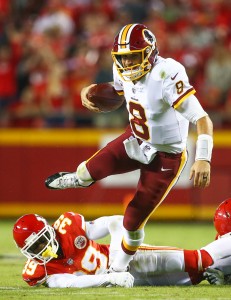 but he is the best quarterback in recent history to reach the open market and QB-needy teams will be rolling out the red carpet for him. The Jets, Vikings, Broncos, and Cardinals have been named as the top suitors for his services, but the NFL is full of surprises this time of year and we would not be surprised to see other teams get involved. The cash-flush Browns are reportedly keen on signing a lower-cost vet and drafting a QB early, but who’s to say they won’t change course and get in on the Cousins sweepstakes? The Bills, Giants, Dolphins, Bucs, and Colts could also consider kicking the tires here, but there are obstacles in that bunch ranging from established starters already in place (Eli Manning, Ryan Tannehill, Jameis Winston, and Andrew Luck) to financial constraints. No matter where he goes, it’s almost certain that Cousins will become the league’s highest-paid player of all-time. That is, until another top-tier QB signs a contract extension soon after.
but he is the best quarterback in recent history to reach the open market and QB-needy teams will be rolling out the red carpet for him. The Jets, Vikings, Broncos, and Cardinals have been named as the top suitors for his services, but the NFL is full of surprises this time of year and we would not be surprised to see other teams get involved. The cash-flush Browns are reportedly keen on signing a lower-cost vet and drafting a QB early, but who’s to say they won’t change course and get in on the Cousins sweepstakes? The Bills, Giants, Dolphins, Bucs, and Colts could also consider kicking the tires here, but there are obstacles in that bunch ranging from established starters already in place (Eli Manning, Ryan Tannehill, Jameis Winston, and Andrew Luck) to financial constraints. No matter where he goes, it’s almost certain that Cousins will become the league’s highest-paid player of all-time. That is, until another top-tier QB signs a contract extension soon after.
2. Drew Brees (Saints): There are multiple possibilities for Cousins but it’s hard to see a scenario in which Brees actually leaves the Saints. Brees has already said that he does not plan on testing free agency, so he’ll likely put pen to paper before things begin on March 14. As far as we can tell, the only way Brees will think about leaving is if he is lowballed to an extreme degree by the Saints, but that seems improbable based on his history with the team
 3. Case Keenum (Vikings): One year ago, no one ever would have expected Keenum to be one of 2018’s most sought-after free agents. The Vikings signed the former Rams signal caller to a one-year, $2MM deal in March with the idea that he would back up Sam Bradford and, eventually slide down to third on the depth chart when/if Teddy Bridgewater returned to full health. When Bradford went down in September, Keenum exceeded all expectations and put together the best season of his career. The 30-year-old graded out as Pro Football Focus’ ninth-ranked QB in 2017, putting him above the likes of Jimmy Garoppolo, Aaron Rodgers, Marcus Mariota, Matthew Stafford, and Tyrod Taylor. With Keenum at the helm, the Vikings earned a first-round bye and beat the Saints in a playoff thriller before succumbing to the Eagles in the NFC championship game. Of course, after four seasons of mediocrity, teams are wondering whether this was an aberration or a real sign of things to come. Teams know that Keenum is not a lock, but he’s also the best Plan B for any team that loses out on Cousins or doesn’t have the means to sign him.
3. Case Keenum (Vikings): One year ago, no one ever would have expected Keenum to be one of 2018’s most sought-after free agents. The Vikings signed the former Rams signal caller to a one-year, $2MM deal in March with the idea that he would back up Sam Bradford and, eventually slide down to third on the depth chart when/if Teddy Bridgewater returned to full health. When Bradford went down in September, Keenum exceeded all expectations and put together the best season of his career. The 30-year-old graded out as Pro Football Focus’ ninth-ranked QB in 2017, putting him above the likes of Jimmy Garoppolo, Aaron Rodgers, Marcus Mariota, Matthew Stafford, and Tyrod Taylor. With Keenum at the helm, the Vikings earned a first-round bye and beat the Saints in a playoff thriller before succumbing to the Eagles in the NFC championship game. Of course, after four seasons of mediocrity, teams are wondering whether this was an aberration or a real sign of things to come. Teams know that Keenum is not a lock, but he’s also the best Plan B for any team that loses out on Cousins or doesn’t have the means to sign him.
4. Andrew Norwell, G (Panthers): There was a time when tackles were the only offensive linemen to really cash in on the open market. That’s no longer the case, as evidenced by the contracts of Kevin Zeitler (five years, $60MM) and Kelechi Osemele (five years, $58.5MM). Osemele inked his free agent deal with the Raiders in 2016 and Zeitler signed his in the 2017 offseason. Given the cap increase and the natural progression of the market, Norwell figures to reset the market for interior linemen. Keenum figures to gross no less than $20MM/year on his next contract, so he’s slotted behind him, but an average annual value of $13-14MM is not out of the question for the former undrafted free agent.
5. Nate Solder, OT (Patriots): Solder isn’t coming off of his best season and he might be the least sexy name in the top ten. Still, there’s a dearth of tackles league-wide and Solder has been among the league’s best at his position for quite some time. The Patriots are bracing for Solder to leave as they fear he’ll garner offers of $12MM/year. No other tackle in this year’s free agent crop is even close to him in terms of ability, so we’re also buying into the hype. Injuries contributed to Solder’s up-and-down season, particularly early on, so teams will take that into account when evaluating him.
6. Allen Robinson, WR (Jaguars): The Jaguars opted against using the franchise tag on Robinson, which is understandable since they have limited cap space. Robinson missed almost all of 2017 with an ACL tear, but his 2015 season (and even his so-so 2016 campaign) gives teams reason to believe that he can be a quality WR1. Robinson is one of only two such players on the unrestricted market, so expect him to get paid. Robinson probably couldn’t do worse than Kenny Britt‘s four-year, $32MM deal with the Browns from last season (and he should do a whole lot better), but if he is underwhelmed by the multi-year offers he receives, he could always go the Alshon Jeffery route. Jeffery inked a one-year, $9.5MM prove-it deal with the Eagles and that turned out to be a smashing success for both parties. Jeffery was rewarded with a four-year, $52MM extension in December, so Robinson’s camp will surely be open to a pillow contract if necessary. 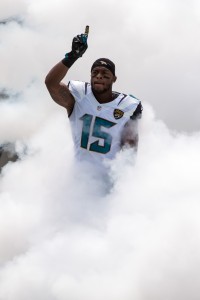
7. Sammy Watkins, WR (Rams): Some may view Robinson and Watkins as 1A and 1B in this year’s wide receiver class, particularly since Robinson missed all of 2017 and Watkins, despite his own injury history, played in all but one of the Rams’ games. Unfortunately, Watkins did not have the platform year he was hoping for as he caught just 39 passes for 593 yards. If we strike Robinson’s lost year and Watkins’ down year from the record, the breakdown favors the Jags receiver – Robinson averaged 77 receptions for 1,078 yards and eight touchdowns per 16 games in that set versus Watkins’ 66 grabs for 1,063 yards and seven scores. These two should come pretty close in average annual value, but we give the edge to Robinson.
8. Trumaine Johnson, CB (Rams): Players often bemoan the franchise tag, but Johnson can’t really complain after receiving two consecutive tags from the Rams and earning more than $30MM between 2016 and 2017. The Rams, rightfully, did not consider a third consecutive tag for Johnson at a cost of ~$20MM and they already have his replacement in Marcus Peters. That’s one suitor down, but plenty of other teams will be eager to speak with Johnson, who profiles as the best cornerback in a deep class.
9. Sheldon Richardson, DT (Seahawks): Richardson gave the Jets lots of headaches, but he also gave them high-end production. He didn’t quite match that production in Seattle, but Richardson is positioned for a massive payday anyway since impactful defensive linemen are at a premium. Our own Dallas Robinson estimates that Richardson will garner about $9MM/year, but I would say that is his floor. The top-end of free agency rarely yields team-friendly deals, so Richardson could easily creep into eight figures in AAV, particularly since he does not turn 28 until November.
10. Dontari Poe, DT (Falcons): Poe thought he was in for a monster contract last offseason, but concerns about his lingering back issues forced him to take a one-year, $8MM deal with Atlanta. Teams may still worry about his back being a ticking time bomb, but perhaps they’ll view him in a different light now that he has played back-to-back 16 game seasons and has only missed two regular season contests over the course of his career.
Top 2018 Free Agents By Position: Defense
NFL free agency will get underway on Wednesday, March 14th, and while the list of free agents will change between now and then, we do have some idea of who will be available when free agency kicks off. The frenzy is right around the corner and it’s time for us to break down the outlook for each position. After looking at offense on Monday, we’ll tackle defense and special teams today.
Listed below are our rankings for the top 15 free agents at each defensive position. These rankings aren’t necessarily determined by the value of the contracts – or the amount of guaranteed money – that each player is expected to land in free agency. These are simply the players we like the most at each position, with both short- and long-term value taken into account.
Restricted and exclusive-rights free agents, as well as players who received the franchise tag, aren’t listed here, since the roadblocks in place to hinder another team from actually acquiring most of those players prevent them from being true free agents.
We’ll almost certainly be higher or lower on some free agents than you are, so feel free to weigh in below in our comments section to let us know which players we’ve got wrong.
Here’s our breakdown of the current top 15 free agents by defensive position for 2018:
Edge defender:
- Julius Peppers
- William Hayes
- Trent Murphy
- Pernell McPhee
- Aaron Lynch
- Alex Okafor
- Adrian Clayborn
- Kony Ealy
- Connor Barwin
- Jeremiah Attaochu
- Junior Galette
- Derrick Shelby
- Barkevious Mingo
- Kareem Martin
- Erik Walden
As a positional group, pass rushers comprise interesting market on the defensive side of the ball. It’s not often that a list of best available players is topped by a 38-year-old, but Peppers is the top free agent edge defender after the Cowboys and Lions deployed the franchise tag on Demarcus Lawrence and Ezekiel Ansah, respectively. As with quarterbacks, NFL clubs are extremely reluctant to allow pass rushers to hit the open market, so top-tier options are rarely ever truly “available.” Peppers, for his part, hasn’t even declared whether he’ll return in 2018, but indications are that he’ll suit up for a 17th campaign after posting 11 sacks last year.
Alongside Peppers, other veterans populate the edge market, and while William Hayes may not be a household name, he’ll be a contributor for whichever team signs him. A stout run defender, Hayes is also capable of generating pressure despite managing only one sack in 2017. The Dolphins used Hayes on only 271 defensive snaps a season ago, and have since replaced him by acquiring fellow defensive end Robert Quinn from the Rams. Now that he’s entering his age-33 season, Hayes should come cheap, but will almost assuredly outplay his contract.
Nearly every other available pass rusher has some sort of flaw which will likely limit his market next week. Trent Murphy is only 27 years old and put up nine sacks in 2016, but he missed the entirety of the 2017 campaign with injury. Pernell McPhee, Alex Okafor, Junior Galette, and Derrick Shelby have also been plagued by health questions in recent seasons. And Adrian Clayborn famously registered the majority of his 2017 sacks (and 20% of his career sack total) in one game against overwhelmed Cowboys backup Chaz Green.
The two names that I keep coming back to are Aaron Lynch (49ers) and Jeremiah Attaochu (Chargers). Yes, Lynch has been suspended for substance abuse, struggled with his weight, and was reportedly in danger of being waived prior to last season. He’s also extremely young (he won’t turn 25 years old until Thursday) and ranked fifth in the league with 34 pass pressures as recently as 2015. Attaochu, a 25-year-old former second-round pick, also has youth on his side, and while he hasn’t quite flashed as much as Lynch, he’s also been buried on LA’s depth chart for much of his career.
Interior defensive line:
- Sheldon Richardson
- Dontari Poe
- Muhammad Wilkerson
- Star Lotulelei
- DaQuan Jones
- Beau Allen
- Denico Autry
- Justin Ellis
- Tom Johnson
- Bennie Logan
- Chris Baker
- Kyle Williams
- Dominique Easley
- Haloti Ngata
- Jay Bromley
Interior rushers are getting more respect in today’s NFL, but that still hasn’t translated to them being paid on the level of edge defenders — the 2018 franchise tag for defensive tackles, for example, is roughly $3MM cheaper than the tender for edge rushers. While the 2018 crop of interior defenders boasts some impressive top-end talent, none of the available players figure to earn a double-digit annual salary. Sheldon Richardson may have the best chance to do so, but Seattle determined he wasn’t worth a one-year cost of $13.939MM, so is any other club going to pay him $10MM per year? I’d guess he comes in closer to $9MM annually, which would still place him among the 25 highest-paid defensive tackles.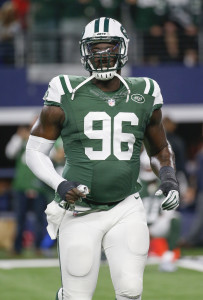
Dontari Poe will be an intriguing free agent case after setting for a one-year deal last offseason, but the most interesting battle among defensive tackles will take place Star Lotulelei and Muhammad Wilkerson, and I’m curious to see which player earns more on the open market. Both are former first-round picks, and it’s difficult to argue Wilkerson hasn’t been the more productive player — or, at least, reached higher highs — than Lotulelei. Wilkerson also won’t affect his next team’s compensatory pick formula given that he was released, but his off-field issues, which include a reported lack of effort and problems with coaches, could limit his appeal.
While Beau Allen and Denico Autry are potentially candidates to be overpaid based on their youth, there are bargains to be had at defensive tackle. Tom Johnson is 33 but he’s offered consistent pressure from the interior for years — his last contract was for three years and $7MM, so he shouldn’t cost much this time around. Haloti Ngata was injured in 2017 but plans to continue his career, and he can still stop the run. And Dominique Easley was outstanding as a 3-4 end in 2016 before missing last season with a torn ACL, meaning the former first-round pick could be a value play for any number of teams.Read more

